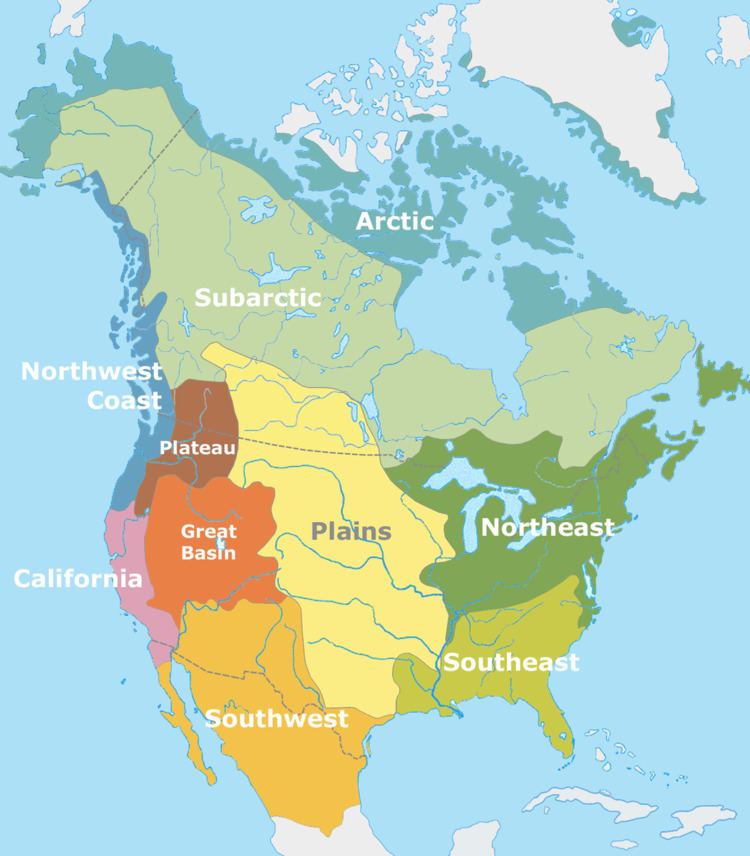 | ||
The Indigenous Peoples of the Great Basin are Native Americans of the northern Great Basin, Snake River Plain, and upper Colorado River basin. The "Great Basin" is a cultural classification of indigenous peoples of the Americas and a cultural region located between the Rocky Mountains and the Sierra Nevada, in what is now Nevada, and parts of Oregon, California, Idaho, Wyoming, and Utah. There is very little precipitation in the Great Basin area which affects the lifestyles and cultures of the inhabitants.
Contents
History
Original inhabitants of the region may have arrived by 12,000 BCE. 9,000 BCE to 400 CE marks the Great Basin Desert Archaic Period, following by the time of the Fremont culture, who were hunter-gatherers, as well as agriculturalists. Numic language-speakers, ancestors of today's Western Shoshone and both Northern and Southern Paiute peoples entered the region around the 14th century CE.
The first Europeans to reach the area was the Spanish Dominguez-Escalante Expedition, who passed far from present day Delta, Utah in 1776. Great Basin settlement was relatively free of non-Native settlers until the first Mormon settlers arrived in 1847. Within ten years, the first Indian reservation was established, in order to assimilate the native population. The Goshute Reservation was created in 1863. The attempted acculturation process included sending children to Indian schools and limiting the landbases and resources of the reservations.
Because their contact with European-Americans and African-Americans occurred comparatively late, Great Basin tribes maintain their religion and culture and were leading proponents of 19th century cultural and religious renewals. Two Paiute prophets, Wodziwob and Wovoka, introduced the Ghost Dance in a ceremony to commune with departed loved ones and bring renewal of buffalo herds and precontact lifeways. The Ute Bear Dance emerged on the Great Basin. The Sun Dance and Peyote religion flourished in the Great Basin, as well.
In 1930, the Ely Shoshone Reservation was established, followed by the Duckwater Indian Reservation in 1940.
Conditions for the Native American population of the Great Basin were erratic throughout the 20th century. Economic improvement emerged as a result of President Franklin Roosevelt's Indian New Deal in the 1930s, while activism and legal victories in the 1970s have improved conditions significantly. Nevertheless, the communities continue to struggle against chronic poverty and all of the resulting problems: unemployment; substance abuse; and high suicide rates.
Today self-determination, beginning with the 1975 passage of the Indian Self-determination and Education Assistance Act, has enabled Great Basin tribes to develop economic opportunities for their members.
Cultures
Different ethnic groups of Great Basin tribes share certain common cultural elements that distinguish them from surrounding groups. All but the Washoe traditionally speak Numic languages, and tribal groups, who historically lived peacefully and often shared common territories, have intermingled considerably. Prior to the 20th century, Great Basin peoples were predominantly hunters and gatherers.
"Desert Archaic" or more simply "The Desert Culture" refers to the culture of the Great Basin tribes. This culture is characterized by the need for mobility to take advantage of seasonally available food supplies. The use of pottery was rare due to its weight, but intricate baskets were woven for containing water, cooking food, winnowing grass seeds and storage—including the storage of pine nuts, a Paiute-Shoshone staple. Heavy items such as metates would be cached rather than carried from foraging area to foraging area. Agriculture was not practiced within the Great Basin itself, although it was practiced in adjacent areas (modern agriculture in the Great Basin requires either large mountain reservoirs or deep artesian wells). Likewise, the Great Basin tribes had no permanent settlements, although winter villages might be revisited winter after winter by the same group of families. In the summer, the largest group was usually the nuclear family due to the low density of food supplies.
In the early historical period the Great Basin tribes were actively expanding to the north and east, where they developed a horse-riding bison-hunting culture. These people, including the Bannock and Eastern Shoshone share traits with Plains Indians.
